�
Mathematical Engineering
For further volumes:
http://www.springer.com/series/8445
Alain Bretto
Hypergraph Theory
An Introduction
123
�
Alain Bretto
Computer Science Department
Universite de Caen
Caen
France
ISSN 2192-4732
ISBN 978-3-319-00079-4
DOI 10.1007/978-3-319-00080-0
Springer Cham Heidelberg New York Dordrecht London
ISSN 2192-4740 (electronic)
ISBN 978-3-319-00080-0
(eBook)
Library of Congress Control Number: 2013932774
Ó Springer International Publishing Switzerland 2013
This work is subject to copyright. All rights are reserved by the Publisher, whether the whole or part of
the material is concerned, specifically the rights of translation, reprinting, reuse of illustrations,
recitation, broadcasting, reproduction on microfilms or in any other physical way, and transmission or
information storage and retrieval, electronic adaptation, computer software, or by similar or dissimilar
methodology now known or hereafter developed. Exempted from this legal reservation are brief
excerpts in connection with reviews or scholarly analysis or material supplied specifically for the
purpose of being entered and executed on a computer system, for exclusive use by the purchaser of the
work. Duplication of this publication or parts thereof is permitted only under the provisions of
the Copyright Law of the Publisher’s location, in its current version, and permission for use must
always be obtained from Springer. Permissions for use may be obtained through RightsLink at the
Copyright Clearance Center. Violations are liable to prosecution under the respective Copyright Law.
The use of general descriptive names, registered names, trademarks, service marks, etc. in this
publication does not imply, even in the absence of a specific statement, that such names are exempt
from the relevant protective laws and regulations and therefore free for general use.
While the advice and information in this book are believed to be true and accurate at the date of
publication, neither the authors nor the editors nor the publisher can accept any legal responsibility for
any errors or omissions that may be made. The publisher makes no warranty, express or implied, with
respect to the material contained herein.
Printed on acid-free paper
Springer is part of Springer Science+Business Media (www.springer.com)
�
Do not worry if you have difficulties in math,
I can assure you mine are far greater
Albert Einstein
�
Preface
Hypergraphs are systems of finite sets and form, probably, the most general
concept in discrete mathematics. This branch of mathematics has developed very
rapidly during the latter part of the twentieth century, influenced by the advent of
computer science. Many theorems on set systems were already known at the
beginning of the twentieth century, but these results did not form a mathematical
field in itself. It was only in the early 1960s that hypergraphs become an inde-
pendent theory. Hence, hypergraph theory is a recent theory. It was mostly
developed in Hungary and France under the leadership of mathematicians like Paul
Erdös, László Lovász, Paul Turán,… but also by C. Berge, for the French school.
Originally, developed in France by Claude Berge in 1960, it is a generalization of
graph theory. The basic idea consists in considering sets as generalized edges and
then in calling hypergraph the family of these edges (hyperedges). As extension of
graphs, many results on trees, cycles, coverings, and colorings of hypergraphs will
be seen in this book.
Hypergraphs model more general types of relations than graphs do. In the past
decades, the theory of hypergraphs has proved to be of a major interest in appli-
cations to real-world problems. These mathematical tools can be used to model
networks, biology networks, data structures, process scheduling, computations and
a variety of other systems where complex relationships between the objects in the
system play a dominant role. From a theoretical point of view, hypergraphs allow
to generalize certain theorems on graphs, even to replace several theorems on
graphs by a single theorem of hypergraphs. For instance, the Berge’s weak perfect
graph conjecture, which says that a graph is perfect if and only if its complement is
perfect, was proved thanks to the concept of normal hypergraph. From a practical
point of view, they are now increasingly preferred to graphs.
In this book, we give a general and nonstandard presentation of the theory of
hypergraphs, although many paragraphs deal with the traditional elements of this
theory.
In Chap. 1, we introduce the basic language of hypergraphs. The last para-
graphs are devoted to more original concepts such as entropy of hypergraph.
Similarities and kernels are also discussed. This chapter could be useful to engi-
neers and anyone interested in applied science.
vii
�
viii
Preface
Chapter 2 provides the first properties such as the Helly property, the König
property, and so on. Standard invariants of hypergraphs are also discussed. In
Chap. 3, the classical notions of colorings are addressed.
In the early 1980s, scientists information theory introduced decomposition-join
approaches into the design and study of databases with large size. A decomposi-
tion of a relation induces a database scheme, that is a hypergraph on the attributer
set. So tree and hypertree decompositions are introduced at the end of Chap. 4, as
well as the concept of acyclicities which are important in computer science. The
first paragraphs are devoted to specific classical hypergraphs. The last paragraph
introduces planarity.
With the emergence of information sciences and life science, the sizes of the
systems we deal with are becoming bigger and bigger. Hence Chap. 5 is devoted to
the reduction of hypergraphs. These reductions make it possible to preserve good
topological, combinatorial, and geometrical properties such as connexity, color-
ings, planarity, and so on. Thus, to solve a problem on hypergraph, we can develop
algorithms on its reduced hypergraph.
Chapter 6 deals with directed hypergraphs. We give some of their basic
properties, then we study the cycles in a directed hypergraph. We also introduce
the notion a algebraic representation of a dirhypergraph.
Chapter 7 gives some applications, not exhaustive and some prospective on
hypergraphs.
To summarize, this book can be divided into three, five, seven chapters or
levels. Three chapters represent learning, five chapters represent the knowledge of
the theory, seven chapters represent the culmination of everything the reader has
worked in the three and five levels.
Paris, December 2012
Alain Bretto
�
Acknowledgments
I make a point of cordially thanking all those who helped me in preparing this
book especially:
• Alain Faisant (Associate Professor to Université de Saint-Étienne),
• Francois Hennercart (Professor to Université de Saint-Étienne),
• Thierry Vallée.
ix
�
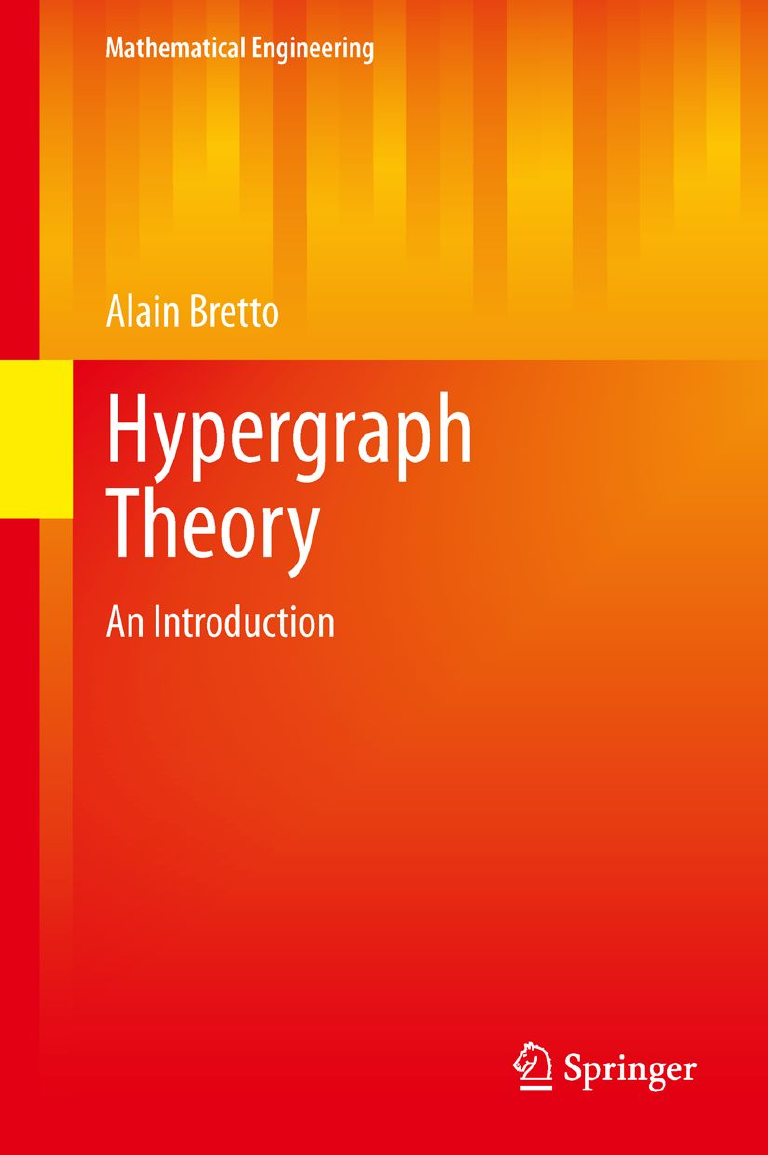

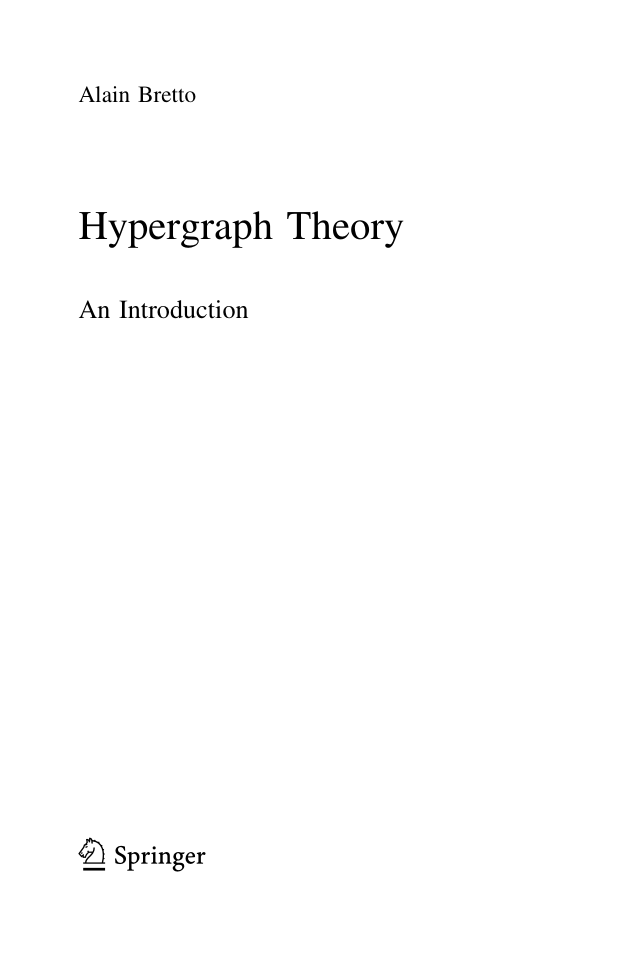
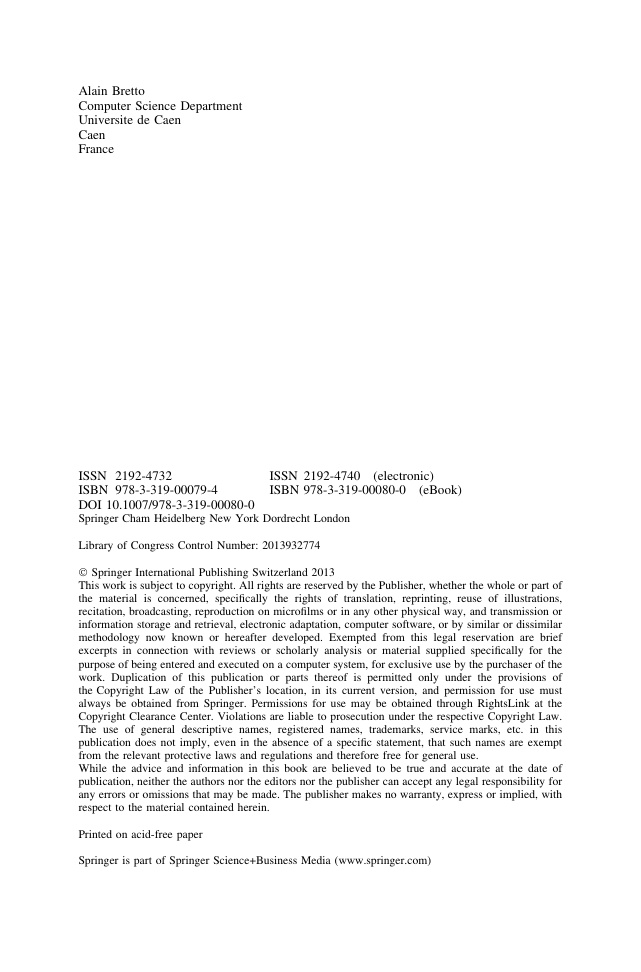

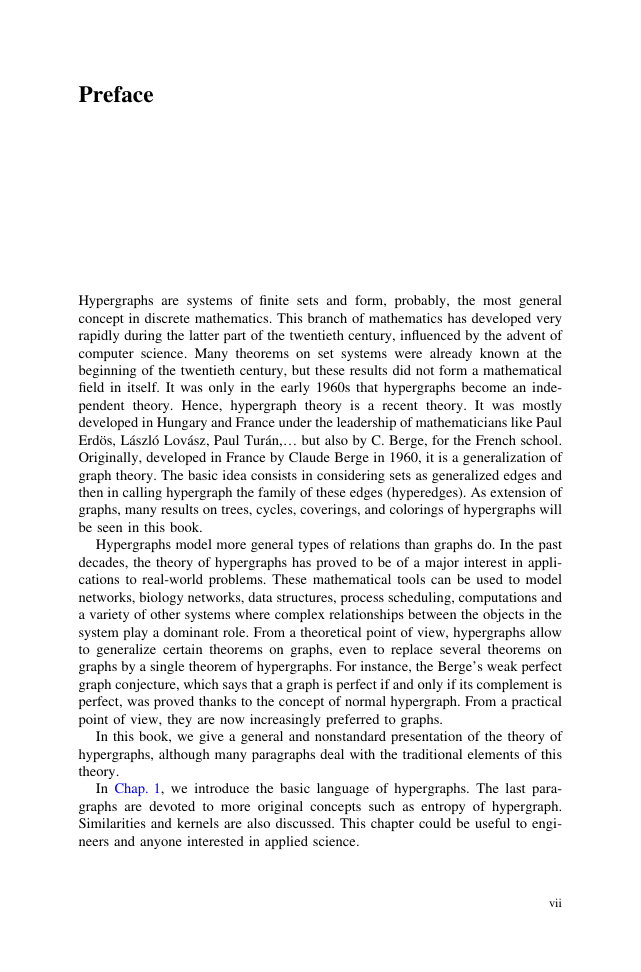
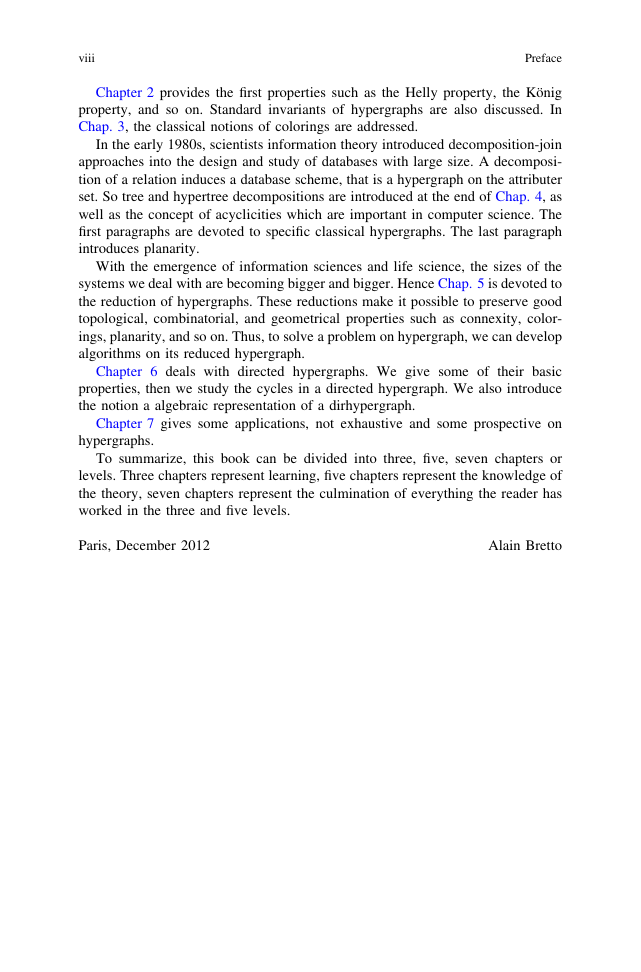









 2023年江西萍乡中考道德与法治真题及答案.doc
2023年江西萍乡中考道德与法治真题及答案.doc 2012年重庆南川中考生物真题及答案.doc
2012年重庆南川中考生物真题及答案.doc 2013年江西师范大学地理学综合及文艺理论基础考研真题.doc
2013年江西师范大学地理学综合及文艺理论基础考研真题.doc 2020年四川甘孜小升初语文真题及答案I卷.doc
2020年四川甘孜小升初语文真题及答案I卷.doc 2020年注册岩土工程师专业基础考试真题及答案.doc
2020年注册岩土工程师专业基础考试真题及答案.doc 2023-2024学年福建省厦门市九年级上学期数学月考试题及答案.doc
2023-2024学年福建省厦门市九年级上学期数学月考试题及答案.doc 2021-2022学年辽宁省沈阳市大东区九年级上学期语文期末试题及答案.doc
2021-2022学年辽宁省沈阳市大东区九年级上学期语文期末试题及答案.doc 2022-2023学年北京东城区初三第一学期物理期末试卷及答案.doc
2022-2023学年北京东城区初三第一学期物理期末试卷及答案.doc 2018上半年江西教师资格初中地理学科知识与教学能力真题及答案.doc
2018上半年江西教师资格初中地理学科知识与教学能力真题及答案.doc 2012年河北国家公务员申论考试真题及答案-省级.doc
2012年河北国家公务员申论考试真题及答案-省级.doc 2020-2021学年江苏省扬州市江都区邵樊片九年级上学期数学第一次质量检测试题及答案.doc
2020-2021学年江苏省扬州市江都区邵樊片九年级上学期数学第一次质量检测试题及答案.doc 2022下半年黑龙江教师资格证中学综合素质真题及答案.doc
2022下半年黑龙江教师资格证中学综合素质真题及答案.doc